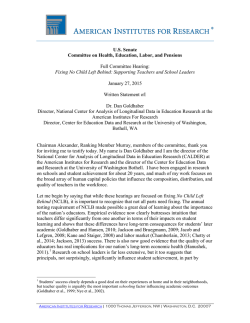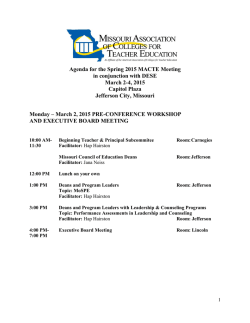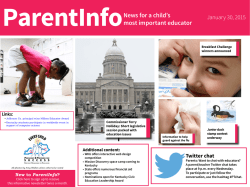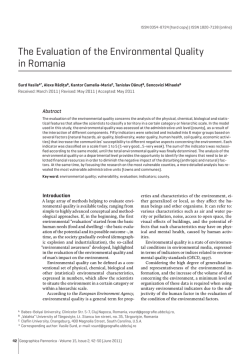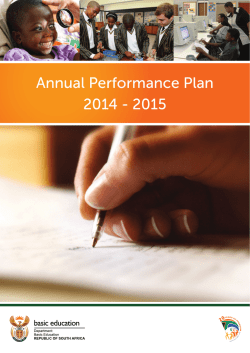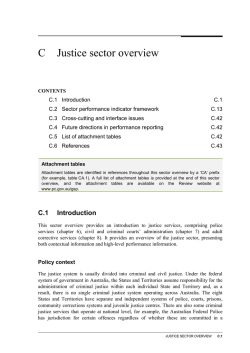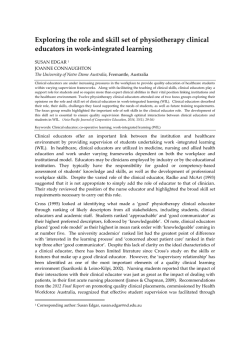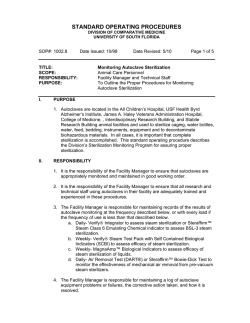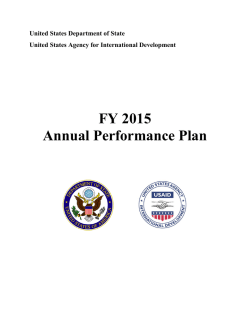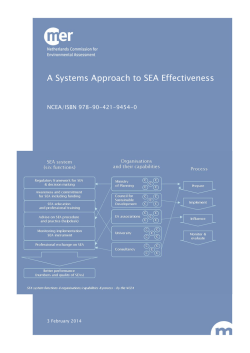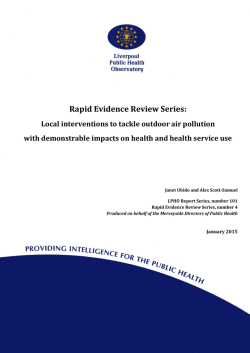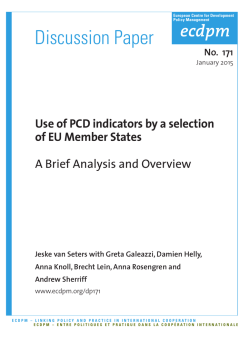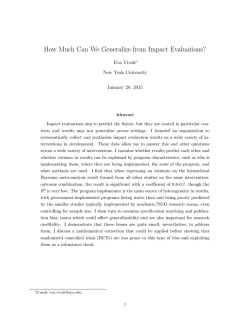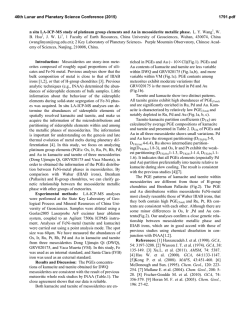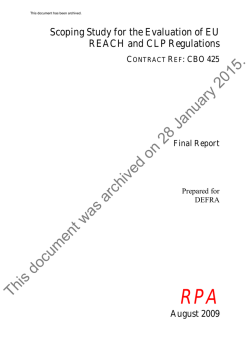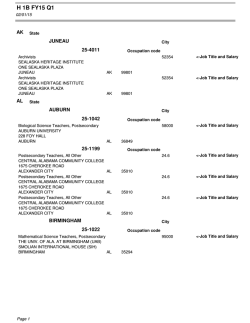
Vision 2015 - Jefferson County Public Schools
Jefferson County Public Schools Strategic Plan Vision 2015 The journey to becoming the best urban district in the nation begins with the first step— Vision 2015! To Our Community, The Jefferson County Public School (JCPS) District is at a critical point in its history. On May 29, 2012, the Jefferson County Board of Education adopted this Strategic Plan to set a course for the district through 2015. This is the result of months of work that started in July when we commissioned a Curriculum Management Audit, which provided us with an external, objective view of how well our current systems and structures support student achievement. Auditors spoke with community leaders, employees, parents, and students. From that feedback, the first priority was to improve the current Central Office organizational structure to better support schools. These reviews compared our current status against audit standards, which reflect the characteristics of a highperforming organization. Those reviews provided us with very specific actions to take to ameliorate any discrepancies between where we are and the standards to which we aspire. Those recommendations are an integral part of this plan. Why do we need a Strategic Plan? The governance role of the Board of Education is to set the direction for the system and to monitor the progress. Every dollar we spend, including every position, needs to be focused on the goals and strategies that will best prepare all of our students for college and career and life in a globally competitive environment. This plan makes our priorities clear, ensures full transparency, and will use measurable outcomes to hold us accountable for maintaining a focus on what will benefit our students. This Strategic Plan will guide and focus our daily work. It will align our efforts to successfully reach our Commonwealth Commitment to the Kentucky Department of Education (KDE) and our commitment to the 55,000 Degrees goals. The success of this plan calls for a commitment from the community and families to work with us as partners to ensure that every student gets the extended learning time and the support needed to master the learning that is expected of him or her. When we work together and implement this plan, we will increase student learning and ensure that “All JCPS students graduate prepared to reach their full potential and contribute to our society throughout life.” Our expectations for our students, our school system, and our community need to be high. We should settle for nothing less than JCPS being the best urban school system in the nation. Our students deserve that. We invite you to commit with us! Jefferson County Board of Education and Superintendent Donna M. Hargens, Ed.D. In June 2014, after two years of implementation, the district took the opportunity to reaffirm those elements of the current plan that we value as most important and effective toward meeting our strategic goals. Based on that review, we have created a more cohesive document to be used for the 2014-15 school year. This streamlined version will serve as a foundation for a more comprehensive review as we move forward in creating a long-term Strategic Plan beyond 2015. 3 Vision 2015 All JCPS students graduate prepared to reach their full potential and contribute to our society throughout life. Mission To provide relevant, comprehensive, quality instruction in order to educate, prepare, and inspire our students to learn Core Values These values guide our work: 1.Our students are cared for and treated as if they are our own. 2.Children learn differently. 3.What happens in the classroom matters the most. 4.The differences of each are assets of the whole. 5.High-quality teaching is the most powerful tool for helping students reach high standards. 6.Leadership and innovation are essential to prepare students for their future. 7.Talents and resources are used wisely to benefit students. 8.Partnerships among schools, families, and community are important for the health and well-being of our students. 9.Adults model integrity, respect, creativity, and accountability. Guiding Practices The following best practices guide our actions and reflect core values embedded across the strategies we identified to achieve the Board of Education goals. 1.Student-focused actions: Select improvement strategies and formulate decisions districtwide that contribute meaningfully to the success of each of our students. 2.Aligned priorities and systems: Design intentional, cohesive systems that align strategic planning, implementation, and evaluation processes with the core standards as well as Board policies. 3.Research-based programs and practices: Plan, monitor, and evaluate district-sponsored strategies, programs, and practices for fidelity and impact. 4.Data-informed decisions: Assess student improvement and inform educator, school, and district practices and decisions by using a balanced approach with multiple sources and kinds of evidence, including authentic assessments. 5.Continuous improvement: Apply short-cycle, continuous improvement methods to regularly monitor strategy implementation and progress toward our goals. 4 JCPS has goals in four focus areas. Increased Learning Graduation and Beyond GOAL GOAL Every student progresses in his or her individual learning. Every student graduates prepared with enduring twenty-first-century skills and dispositions for his or her postsecondary choices and life. Safe, Resourced, Supported, and Equipped Schools Stakeholder Involvement/ Engagement GOAL GOAL Increase partnerships with parents, community, and educational organizations to enrich student learning and experiences. Every educator will provide effective instruction and response to student needs. The district provides safe, well-staffed, and well-resourced schools to support the needs of every student. 5 Our Strategy Focus Area: Increased Learning GOAL Every student progresses in his or her individual learning. TARGETS 1.Elementary (K–8) Reading and Math Performance: Increase the average combined reading and math Kentucky Performance Rating for Educational Progress (K-PREP) scores for elementary and middle school students from 44.6 percent in 2014 to 56 percent in 2015. 2.Proficiency Gaps (K–12) in Reading and Math Performance: Increase the average combined reading and math proficiency ratings for all students in the nonduplicated gap group (African American, Hispanic, Native American, With Disability, Free/Reduced-Price Meals, Limited English Proficiency) from 34 percent in 2014 to 51.2 percent in 2015. STRATEGIES Strategy 1.1 Responsive, differentiated instruction Differentiate and individualize instruction aligned with the written and assessed curriculum to engage and meet the needs of the whole child. Key Indicator: Increase in the proficiency rates on district benchmark assessments for all students and gap groups at the elementary and middle school levels Strategy 1.2 Equitable learning opportunities Provide equitable learning experiences, aligned to the effective teaching practices in the Danielson Framework, that will support the success of diverse learners. Key Indicator: Increase in the average rating on the Professional Growth and Effectiveness System (PGES) classroom observations Strategy 1.3 Early learning and student readiness Create a coordinated system of early learning interventions that span pre-K through third grade to ensure all Primary students are performing at grade level. Key Indicator: Increase in the kindergarten-readiness scores and Primary assessment scores 6 Our Strategy Focus Area: Graduation and Beyond GOAL Every student graduates prepared with enduring twenty-firstcentury skills and dispositions for his or her postsecondary choices and life. TARGETS 1.High School Graduation: Increase the Four-Year Adjusted Cohort Graduation Rate from 79 percent in 2014 to 81.3 percent by 2015. 2.Graduates Ready for College and Career: Increase the percentage of students who are college- and career-ready from 60.5 percent in 2014 to 65.5 percent by 2015. STRATEGIES: Strategy 2.1 Student advising and planning Implement guidance and advisement structures that will facilitate the development, refinement, and implementation of each student’s college/career plan. Key Indicator: Increase in the percentage of students reporting that school staff prepare them for college/career Strategy 2.2 Career pathways and dual pathways Provide options for academic pathways and programs that will prepare students for their career and college plans. Key Indicators: (1) Increase in the percentage of students enrolled in School of Study Programs or Career Themes (2) Increase in the percentage of students enrolled in dual-credit and Advanced Placement (AP) courses. Strategy 2.3 Transition support between levels Prepare and support students during transitions between school levels (elementary to middle to high to postsecondary) as well as transitions between grades, schools, and programs. Key Indicators: (1) Increase in the percentage of students enrolling in postsecondary institutions (2) Decrease in grade-level retention rates 7 Our Strategy Focus Area: Stakeholder Involvement/ Engagement GOAL Increase partnerships with parents, community, and educational organizations to enrich student learning and experiences. TARGETS 1. Parent/Caregiver Satisfaction: Increase parental satisfaction from 89.9 percent in 2014 to 91 percent by 2015. 2.Community Partnerships: Increase service hours provided to JCPS by major community partners (baseline 2015). STRATEGIES: Strategy 3.1 Communication and relationships Develop regular, transparent communication processes and structures that promote district and school information sharing (e.g., district and school priorities, policies, changes, and results) and response (e.g., stakeholder questions and suggestions) in ways that build community relationships and meet needs. Key Indicator: Increase in the number of district communications to stakeholders Strategy 3.2 Fostering postsecondary opportunities Work collaboratively with partners (e.g., community organizations, postsecondary schools, 55,000 Degrees) to identify and provide college- and career-focused opportunities that meet student needs and interests and prepare them for the workforce and further education. Key Indicator: Increase in the number and quality of opportunities available to students Strategy 3.3 Student-community enrichment Collaborate with the community and parents to provide innovative and effective enrichment opportunities and interventions for pre-K through twelfth-grade students to extend learning in core areas as well as the arts, service learning, and personal growth. Key Indicators: (1) Increase in the number of students reporting participating in service learning opportunities (2) Increase in the number of students served by community learning centers Strategy 3.4 Parent/Caregiver engagement Create relationships with parents/caregivers and family outreach organizations to develop strategies focusing on shared responsibilities that support students’ learning in the classroom and at home. Key Indicators: (1) Increase in the percentage of parents reporting opportunities to discuss their child’s progress (2) Increase in the use of Parent Portal 8 Our Strategy Focus Area: Safe, Resourced, Supported, and Equipped Schools GOAL 1: Goal 2: TARGETS 1.Effective Teachers: TARGETS 1.Instructional Funding: Every educator will provide effective instruction and response to student needs. The district provides safe, wellstaffed, and well-resourced schools to support the needs of every student. Increase the percentage of effective teachers (baseline 2015). 2. Effective Principals: Increase the percentage of effective principals (baseline 2015). Increase the total proportion of general funds directed to instruction and achievement from 54 percent in 2013 to 55 percent by 2015. 2.Interventions: Increase the percentage of Novice students receiving interventions and supports (baseline 2015). STRATEGIES PER GOAL: Strategy 4.1.1 Professional Learning Communities (PLCs) Strategy 4.2.1 Service-oriented, productive, and efficient systems linked with student success Build capacity of PLCs in the areas of differentiated instruction and assessment literacy while promoting a collective vision for and shared ownership of student success. Key Indicator: Increased average ratings on Professional Responsibilities scale on PGES classroom observations Create Central Office services, structures, and budgeting methods, aligned with district priorities and best practices that meet school needs and promote student success. Key Indicator: Increase in the percentage of funds directed to schools Strategy 4.1.2 Professional development Strategy 4.2.2 Access, equity, and safety Develop a system of ongoing, responsive professional learning that promotes professional growth and aligns to the educator effectiveness system and equitably supports improved student learning, growth, and development. Key Indicator: Increase in the percentage of teachers reporting participating in professional learning Provide programs, services, and resources (e.g., funding, materials, high-quality teachers prepared to support diverse students) in ways that promote access, equity, and a sense of safety and security to all students in every school. Key Indicators: (1) Increased ratings of students’ sense of belonging and safety (2) Increase in highly qualified staff trained to meet diverse student needs Strategy 4.1.3 Educator growth and effectiveness Strategy 4.2.3 Intervention and response Develop and implement the Educator Growth System (EGS) to promote effective instruction and learning by collaborating with postsecondary schools, the Jefferson County Teachers Association (JCTA), Jefferson County Association of School Administrators (JCASA), and Kentucky Department of Education (KDE). Key Indicator: Increased ratings on EGS (classroom observations and student surveys) Implement a coordinated system of academic and behavioral supports and interventions for students that is flexible and timely to the needs of each student for optimal success. Key Indicators: (1) Increase in student attendance rates (2) Decrease in student suspension rates (3) Increase in the number of students served in interventions 9 Jefferson County Public Schools Louisville, Kentucky Donna M. Hargens, Ed.D. Superintendent www.jcpsky.net Equal Opportunity/ Affirmative Action Employer Offering Equal Educational Opportunities 30640Vision2015StrategicPlnStreamlinedrevkw 11/14
© Copyright 2025

